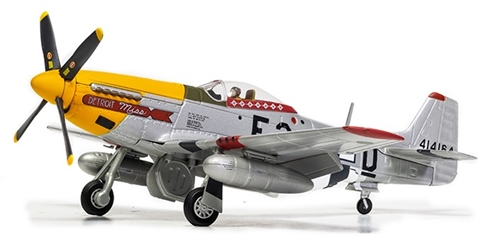Corgi WWII War in Europe: 1939-1945 Series (1:72 Scale)
Corgi WWII War in Europe: 1939-1945 Series (1:72 Scale)
 Air warfare was a major component in all theaters of World War II, and, together with anti-aircraft warfare, consumed a large fraction of the industrial output of the major powers. Germany and Japan depended on air forces that were closely integrated with land and naval forces; the Axis powers downplayed the advantage of fleets of strategic bombers, and were late in appreciating the need to defend against Allied strategic bombing. By contrast, Britain and the United States took an approach that greatly emphasized strategic bombing, and (to a lesser degree) tactical control of the battlefield by air, as well as adequate air defenses. Both Britain and the U.S. built substantially larger strategic forces of large, long-range bombers. Simultaneously, they built tactical air forces that could win air superiority over the battlefields, thereby giving vital assistance to ground troops. The U.S. and Royal Navy also built a powerful naval-air component based on aircraft carriers, as did the Japanese; these played the central role in the war at sea.
Air warfare was a major component in all theaters of World War II, and, together with anti-aircraft warfare, consumed a large fraction of the industrial output of the major powers. Germany and Japan depended on air forces that were closely integrated with land and naval forces; the Axis powers downplayed the advantage of fleets of strategic bombers, and were late in appreciating the need to defend against Allied strategic bombing. By contrast, Britain and the United States took an approach that greatly emphasized strategic bombing, and (to a lesser degree) tactical control of the battlefield by air, as well as adequate air defenses. Both Britain and the U.S. built substantially larger strategic forces of large, long-range bombers. Simultaneously, they built tactical air forces that could win air superiority over the battlefields, thereby giving vital assistance to ground troops. The U.S. and Royal Navy also built a powerful naval-air component based on aircraft carriers, as did the Japanese; these played the central role in the war at sea.
Before 1939, all sides operated under largely theoretical models of air warfare. Italian theorist Giulio Douhet in the 1920s summarized the faith that airmen during and after World War I developed in the efficacy of strategic bombing. Many said it alone could win wars, as "the bomber will always get through". The Americans were confident that the Boeing B-17 Flying Fortress bomber could reach targets, protected by its own weapons, and bomb, using the Norden bomb sight, with "pickle barrel" accuracy. Japanese aviation pioneers felt that they had developed the finest naval aviators in the world.
#AA27707 - RAF Bristol Beaufighter TF.X Torpedo Bomber - No.45 Squadron "Operation Firedog", RAF Kuala Lumpur, Malaya, 1949 (1:72 Scale)
|
|
|





 Air warfare was a major component in all theaters of World War II, and, together with anti-aircraft warfare, consumed a large fraction of the industrial output of the major powers. Germany and Japan depended on air forces that were closely integrated with land and naval forces; the Axis powers downplayed the advantage of fleets of strategic bombers, and were late in appreciating the need to defend against Allied strategic bombing. By contrast, Britain and the United States took an approach that greatly emphasized strategic bombing, and (to a lesser degree) tactical control of the battlefield by air, as well as adequate air defenses. Both Britain and the U.S. built substantially larger strategic forces of large, long-range bombers. Simultaneously, they built tactical air forces that could win air superiority over the battlefields, thereby giving vital assistance to ground troops. The U.S. and Royal Navy also built a powerful naval-air component based on aircraft carriers, as did the Japanese; these played the central role in the war at sea.
Air warfare was a major component in all theaters of World War II, and, together with anti-aircraft warfare, consumed a large fraction of the industrial output of the major powers. Germany and Japan depended on air forces that were closely integrated with land and naval forces; the Axis powers downplayed the advantage of fleets of strategic bombers, and were late in appreciating the need to defend against Allied strategic bombing. By contrast, Britain and the United States took an approach that greatly emphasized strategic bombing, and (to a lesser degree) tactical control of the battlefield by air, as well as adequate air defenses. Both Britain and the U.S. built substantially larger strategic forces of large, long-range bombers. Simultaneously, they built tactical air forces that could win air superiority over the battlefields, thereby giving vital assistance to ground troops. The U.S. and Royal Navy also built a powerful naval-air component based on aircraft carriers, as did the Japanese; these played the central role in the war at sea.